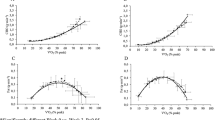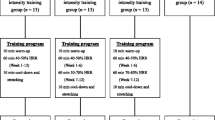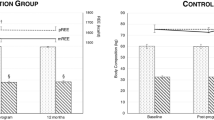Abstract
Purpose
To investigate the effects of a 3-week weight-management program entailing moderate energy restriction, nutritional education, psychological counseling and three different exercise training (a: low intensity, LI: 40 % V′O2max; b: high intensity, HI: 70 % V′O2max; c: high-intensity interval training, HIIT), on body composition, energy expenditure and fat oxidation rate in obese adolescents.
Methods
Thirty obese adolescents (age: 15–17 years, BMI: 37.5 kg m−2) participated in this study. Before starting (week 0, W0) and at the end of the weight-management program (week 3, W3), body composition was assessed by an impedancemeter; basal metabolic rate (BMR), energy expenditure and substrate oxidation rate were measured during exercise and post-exercise recovery by indirect calorimetry.
Results
At W3, body mass (BM) and fat mass (FM) decreased significantly in all groups, the decreases being significantly greater in the LI than in the HI and HIIT subgroups (BM: −8.4 ± 1.5 vs −6.3 ± 1.9 vs −4.9 ± 1.3 kg and FM: −4.2 ± 1.9 vs −2.8 ± 1.2 vs −2.3 ± 1.4 kg, p < 0.05, respectively). V′O2peak, expressed in relative values, changed significantly only in the HI and HIIT groups by 0.009 ± 0.005 and 0.007 ± 0.004 L kg FFM−1 min−1 (p < 0.05). Furthermore, the HI and HIIT subgroups exhibited a greater absolute rate of fat oxidation between 50 and 70 % V′O2peak at W3. No significant changes were observed at W3 in BMR, energy expenditure during exercise and post-exercise recovery.
Conclusion
A 3-week weight-management program induced a greater decrease in BM and FM in the LI than in the HI and HIIT subgroups, and greater increase in V′O2peak and fat oxidation rate in the HI and HIIT than in the LI subgroup.

Similar content being viewed by others
References
Verrotti A, Penta L, Zenzeri L, Agostinelli S, De Feo P (2014) Childhood obesity: prevention and strategies of intervention. A systematic review of school-based interventions in primary schools. J Endocrinol Invest 37(12):1155–1164. doi:10.1007/s40618-014-0153-y
Swinburn B, Ravussin E (1993) Energy balance or fat balance? Am J Clin Nutr 57(5 Suppl):766S–770S
van Baak MA, van Mil E, Astrup AV, Finer N, Van Gaal LF, Hilsted J, Kopelman PG, Rossner S, James WP, Saris WH (2003) Leisure-time activity is an important determinant of long-term weight maintenance after weight loss in the Sibutramine Trial on Obesity Reduction and Maintenance (STORM trial). Am J Clin Nutr 78(2):209–214
Saris WH, Blair SN, van Baak MA, Eaton SB, Davies PS, Di Pietro L, Fogelholm M, Rissanen A, Schoeller D, Swinburn B, Tremblay A, Westerterp KR, Wyatt H (2003) How much physical activity is enough to prevent unhealthy weight gain? Outcome of the IASO 1st Stock Conference and consensus statement. Obes Rev 4(2):101–114
Lafortuna CL, Lazzer S, Agosti F, Busti C, Galli R, Mazzilli G, Sartorio A (2009) Metabolic responses to submaximal treadmill walking and cycle ergometer pedalling in obese adolescents. Scand J Med Sci Sports 23:23
Brandou F, Savy-Pacaux AM, Marie J, Bauloz M, Maret-Fleuret I, Borrocoso S, Mercier J, Brun JF (2005) Impact of high- and low-intensity targeted exercise training on the type of substrate utilization in obese boys submitted to a hypocaloric diet. Diabetes Metab 31(4 Pt 1):327–335
Lazzer S, Lafortuna C, Busti C, Galli R, Tinozzi T, Agosti F, Sartorio A (2010) Fat oxidation rate during and after a low- or high-intensity exercise in severely obese Caucasian adolescents. Eur J Appl Physiol 108(2):383–391. doi:10.1007/s00421-009-1234-z
van Aggel-Leijssen DP, Saris WH, Wagenmakers AJ, Senden JM, van Baak MA (2002) Effect of exercise training at different intensities on fat metabolism of obese men. J Appl Physiol 92(3):1300–1309
Garcia-Hermoso A, Cerrillo-Urbina AJ, Herrera-Valenzuela T, Cristi-Montero C, Saavedra JM, Martinez-Vizcaino V (2016) Is high-intensity interval training more effective on improving cardiometabolic risk and aerobic capacity than other forms of exercise in overweight and obese youth? A meta-analysis. Obes Rev 17(6):531–540. doi:10.1111/obr.12395
Lambrick D, Westrupp N, Kaufmann S, Stoner L, Faulkner J (2016) The effectiveness of a high-intensity games intervention on improving indices of health in young children. J Sports Sci 34(3):190–198. doi:10.1080/02640414.2015.1048521
Armstrong N, Tomkinson G, Ekelund U (2011) Aerobic fitness and its relationship to sport, exercise training and habitual physical activity during youth. Br J Sports Med 45(11):849–858. doi:10.1136/bjsports-2011-090200
Corte de Araujo AC, Roschel H, Picanco AR, do Prado DM, Villares SM, de Sa Pinto AL, Gualano B (2012) Similar health benefits of endurance and high-intensity interval training in obese children. PLoS ONE 7(8):e42747. doi:10.1371/journal.pone.0042747
Ramos JS, Dalleck LC, Tjonna AE, Beetham KS, Coombes JS (2015) The impact of high-intensity interval training versus moderate-intensity continuous training on vascular function: a systematic review and meta-analysis. Sports Med 45(5):679–692. doi:10.1007/s40279-015-0321-z
Lunt H, Draper N, Marshall HC, Logan FJ, Hamlin MJ, Shearman JP, Cotter JD, Kimber NE, Blackwell G, Frampton CM (2014) High intensity interval training in a real world setting: a randomized controlled feasibility study in overweight inactive adults, measuring change in maximal oxygen uptake. PLoS ONE 9(1):e83256. doi:10.1371/journal.pone.0083256
Costigan SA, Eather N, Plotnikoff RC, Taaffe DR, Lubans DR (2015) High-intensity interval training for improving health-related fitness in adolescents: a systematic review and meta-analysis. Br J Sports Med 49(19):1253–1261. doi:10.1136/bjsports-2014-094490
Alkahtani SA, King NA, Hills AP, Byrne NM (2013) Effect of interval training intensity on fat oxidation, blood lactate and the rate of perceived exertion in obese men. Springerplus 2:532. doi:10.1186/2193-1801-2-532597
Buchheit M, Laursen PB (2013) High-intensity interval training, solutions to the programming puzzle: part I: cardiopulmonary emphasis. Sports Med 43(5):313–338. doi:10.1007/s40279-013-0029-x
Cacciari E, Milani S, Balsamo A, Spada E, Bona G, Cavallo L, Cerutti F, Gargantini L, Greggio N, Tonini G, Cicognani A (2006) Italian cross-sectional growth charts for height, weight and BMI (2 to 20 yr). J Endocrinol Invest 29(7):581–593
Tanner JM (1962) Growth at adolescence, 2nd edn. UK, Oxford
Nutrition ISo (1996) Recommended levels of energy and nutrients intake for the Italian population (LARN). Edra Medical Publishing and New Media, Milano
Lukaski HC (1987) Methods for the assessment of human body composition: traditional and new. Am J Clin Nutr 46(4):537–556
Lazzer S, Bedogni G, Agosti F, De Col A, Mornati D, Sartorio A (2008) Comparison of dual-energy X-ray absorptiometry, air displacement plethysmography and bioelectrical impedance analysis for the assessment of body composition in severely obese Caucasian children and adolescents. Br J Nutr 100(4):918–24. doi:10.1017/S0007114508922558
Weir JB (1949) New methods for calculating metabolic rate with special references to protein metabolism. J Physiol (Lond) 109:1–9
Achten J, Gleeson M, Jeukendrup AE (2002) Determination of the exercise intensity that elicits maximal fat oxidation. Med Sci Sports Exerc 34(1):92–97
Frayn KN (1983) Calculation of substrate oxidation rates in vivo from gaseous exchange. J Appl Physiol 55(2):628–634
Gutin B, Barbeau P, Owens S, Lemmon CR, Bauman M, Allison J, Kang HS, Litaker MS (2002) Effects of exercise intensity on cardiovascular fitness, total body composition, and visceral adiposity of obese adolescents. Am J Clin Nutr 75(5):818–826
Sothern MS, Loftin M, Suskind RM, Udall JN Jr, Blecker U (1999) The impact of significant weight loss on resting energy expenditure in obese youth. J Investig Med 47(5):222–226
Flatt JP (1993) Dietary fat, carbohydrate balance, and weight maintenance. Ann N Y Acad Sci 683:122–140
Maffeis C, Zaffanello M, Pellegrino M, Banzato C, Bogoni G, Viviani E, Ferrari M, Tato L (2005) Nutrient oxidation during moderately intense exercise in obese prepubertal boys. J Clin Endocrinol Metab 90(1):231–236 Epub 2004 Oct 2013
Saavedra JM, García-Hermoso A, Escalante Y, Domínguez AM (2014) Self-determined motivation, physical exercise and diet in obese children: a three-year follow-up study. Int J Clin Health Psychol 14:195–201
Bond B, Hind S, Williams CA, Barker AR (2015) The acute effect of exercise intensity on vascular function in adolescents. Med Sci Sports Exerc 47(12):2628–2635. doi:10.1249/MSS.0000000000000715
Astorino TA, Allen RP, Roberson DW, Jurancich M (2012) Effect of high-intensity interval training on cardiovascular function, VO2max, and muscular force. J Strength Cond Res 26(1):138–145. doi:10.1519/JSC.0b013e318218dd7700124278-201201000-00018
Burgomaster KA, Howarth KR, Phillips SM, Rakobowchuk M, Macdonald MJ, McGee SL, Gibala MJ (2008) Similar metabolic adaptations during exercise after low volume sprint interval and traditional endurance training in humans. J Physiol 586(1):151–160. doi:10.1113/jphysiol.2007.142109
Gavarry O, Aguer C, Delextrat A, Lentin G, Ayme K, Boussuges A (2015) Severely obese adolescent girls rely earlier on carbohydrates during walking than normal-weight matched girls. J Sports Sci 33(18):1871–1880. doi:10.1080/02640414.2015.1021274
Perez-Martin A, Dumortier M, Raynaud E, Brun JF, Fedou C, Bringer J, Mercier J (2001) Balance of substrate oxidation during submaximal exercise in lean and obese people. Diabetes Metab 27(4 Pt 1):466–474
Boushel R, Gnaiger E, Schjerling P, Skovbro M, Kraunsoe R, Dela F (2007) Patients with type 2 diabetes have normal mitochondrial function in skeletal muscle. Diabetologia 50(4):790–796. doi:10.1007/s00125-007-0594-3
Koves TR, Ussher JR, Noland RC, Slentz D, Mosedale M, Ilkayeva O, Bain J, Stevens R, Dyck JR, Newgard CB, Lopaschuk GD, Muoio DM (2008) Mitochondrial overload and incomplete fatty acid oxidation contribute to skeletal muscle insulin resistance. Cell Metab 7(1):45–56. doi:10.1016/j.cmet.2007.10.013
Aucouturier J, Duche P, Timmons BW (2011) Metabolic flexibility and obesity in children and youth. Obes Rev 12(5):e44–e53. doi:10.1111/j.1467-789X.2010.00812.x
McMurray RG, Hackney AC (2005) Interactions of metabolic hormones, adipose tissue and exercise. Sports Med 35(5):393–412. doi:10.2165/00007256-200535050-00003
Eliakim A, Nemet D, Zaldivar F, McMurray RG, Culler FL, Galassetti P, Cooper DM (2006) Reduced exercise-associated response of the GH-IGF-I axis and catecholamines in obese children and adolescents. J Appl Physiol 100(5):1630–1637. doi:10.1152/japplphysiol.01072.2005
Lazzer S, Bedogni G, Lafortuna CL, Marazzi N, Busti C, Galli R, De Col A, Agosti F, Sartorio A (2009) Relationship between basal metabolic rate, gender, age, and body composition in 8,780 white obese subjects. Obesity 28:28
Lazzer S, Boirie Y, Bitar A, Montaurier C, Vernet J, Meyer M, Vermorel M (2003) Assessment of energy expenditure associated with physical activities in free-living obese and nonobese adolescents. Am J Clin Nutr 78(3):471–479
Stiegler P, Cunliffe A (2006) The role of diet and exercise for the maintenance of fat-free mass and resting metabolic rate during weight loss. Sports Med 36(3):239–262
Smith J, Mc Naughton L (1993) The effects of intensity of exercise on excess postexercise oxygen consumption and energy expenditure in moderately trained men and women. Eur J Appl Physiol Occup Physiol 67(5):420–425
Phelain JF, Reinke E, Harris MA, Melby CL (1997) Postexercise energy expenditure and substrate oxidation in young women resulting from exercise bouts of different intensity. J Am Coll Nutr 16(2):140–146
Saris WH, Schrauwen P (2004) Substrate oxidation differences between high- and low-intensity exercise are compensated over 24 hours in obese men. Int J Obes Relat Metab Disord 28(6):759–765
Melanson EL, Sharp TA, Seagle HM, Horton TJ, Donahoo WT, Grunwald GK, Hamilton JT, Hill JO (2002) Effect of exercise intensity on 24-h energy expenditure and nutrient oxidation. J Appl Physiol 92(3):1045–1052
Acknowledgments
We are grateful to the adolescents (and their parents) for participating in the present study, to the nursing staff of the Division of Auxology, Italian Institute for Auxology, IRCCS, for their qualified assistance during the clinical study. The study was supported by Progetti di Ricerca Corrente, Istituto Auxologico Italiano, Milan, Italy.
Author information
Authors and Affiliations
Corresponding author
Ethics declarations
Conflict of interest
The authors declare that they have no conflict of interest.
Ethical approval
The study was approved by the Ethics Committee of the Italian Institute for Auxology (Milan).
Informed consent
Written informed consent was obtained before beginning the study.
Rights and permissions
About this article
Cite this article
Lazzer, S., Tringali, G., Caccavale, M. et al. Effects of high-intensity interval training on physical capacities and substrate oxidation rate in obese adolescents. J Endocrinol Invest 40, 217–226 (2017). https://doi.org/10.1007/s40618-016-0551-4
Received:
Accepted:
Published:
Issue Date:
DOI: https://doi.org/10.1007/s40618-016-0551-4




